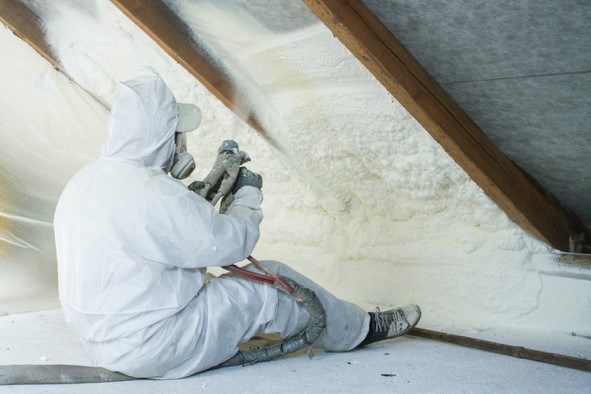Using Spray Polyurethane Foam With BlazeMaster® Fire Sprinkler Systems
Spray Polyurethane Foam (SPUF) has been used successfully with BlazeMaster® pipe and fitting systems for more than 20 years, primarily in the attics and walls of single-family homes that have fire sprinklers. SPUF is an increasingly popular insulation that enhances energy efficiency and improves comfort in the home.
When installing SPUF around CPVC pipe and fittings, it’s important to use proper installation techniques to prevent issues related to chemical compatibility and heat generated during application. Here are best practices to ensure your project is a success.
Ensure Chemical Compatibility of SPUF With CPVC
Lubrizol assisted the Spray Polyurethane Foam Alliance on an in-depth 2009 study that found that the SPUFs tested did not pose any chemical compatibility issues. Here are three things to keep in mind:
Start by checking the FBC™ System Compatible Program. The website provides everything you need to know to ensure ancillary materials are compatible with BlazeMaster fire sprinkler systems. For information on SPUF, visit the “Other Compatibility Topics” section and navigate to “Polyurethane Spray-On Foams.” For general filling of gaps around Lubrizol-branded pipe, visit “Gap Filling.” For filling gaps in wall or floor penetrations, RTV silicone sealant or polyurethane "foam-in-a-can" may be used.
Mix SPUF components in the right ratio. SPUF is often applied with equipment that mixes two liquid chemical components through a spray nozzle. Individually, these two components are not chemically compatible with CPVC. But when mixed in the right ratio and applied in the right thickness, they are safe to use. Once applied, the two components quickly react with each other and foam up, creating a solidified foam structure with good insulating properties – and no effect on CPVC. However, if the two components are not properly mixed, the unreacted excess left on pipes can create problems in the pipe and fittings.
Keep the area dry. If SPUF becomes wet for any reason, remove any foam and also the pipe in the area that got wet. The water can wash incompatible additives out of the foam and deposit them onto the CPVC pipe, creating a potential for future leaks.
Managing Heat Generated When Applying SPUF
The SPUF installation process generates a lot of heat that is not easily dissipated because of SPUF’s excellent insulation properties. Without proper techniques, temperatures can quickly rise above the boiling point of water and the softening point of CPVC. But these issues can be managed with the following best practices.
Apply in layers to allow the SPUF to cool. Follow the manufacturer’s instructions on the maximum thickness of a layer and the wait times between applications. SPFA recommends:
- Keep SPUF internal temperatures at or below about 180° F during the application/reaction process.
- Apply the first pass so that it just touches the pipe. After sufficient cooling, apply a second pass to achieve final thickness (Figure 1). An optional protective pass over the pipe may be used between the passes, as shown by the dashed red line.
- Avoid application where pipe is positioned at the thickness of the pass where it will be exposed to high temperatures as the SPUF cures (Figure 2).
- Take extra care when applying SPUF in awkward building cavities where it may be challenging to keep layers below the allowable thickness.
 |
 |
Keep the sprinkler system empty and unpressurized when the insulation is installed. If the pipe is filled with water and/or pressurized, the pipe may balloon if temperatures exceed the point where water boils and/or CPVC softens. This causes the walls to become stretched and thin and could lead to rupture. If the pipe is heated above its softening point without being filled and/or pressurized, it won’t balloon and will harden back up when the temperature falls.
Compensate for thermal expansion in the system design to allow for the heat generated by SPUF as it cures. If long runs of pipe will be buried in SPUF, expansion loops or offsets may be necessary to account for the expansion of the pipe due to the heat. If expansion is not properly accounted for in the design, excessive stress can be concentrated in areas (typically elbow or tee fittings) where expansion is restrained. Installation manuals available from the piping manufacturers give advice on proper design and placement of thermal expansion compensation.
If you have any questions about SPUF or other topics, don’t hesitate to contact us for expert advice. You can also learn more through our online video series, Understanding Chemical Compatibility.


